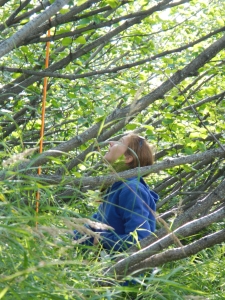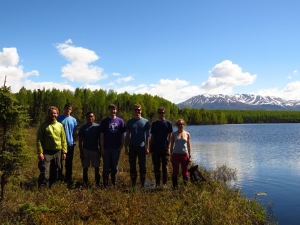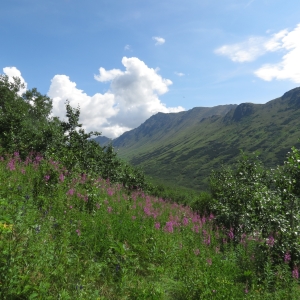APU student Christina Rinas, ’15, is a National Wildlife Federation Campus Ecology Fellow pursuing a master’s degree in environmental science while working with APU professor Roman Dial. She is a member of the Emerging Leader’s Council, where her day-to-day work involves plant ecology research.
Her APU fieldwork focuses on alpine vegetation and forms the basis for her thesis on changes in shrub cover and abundance in the alpine zone of the Chugach Mountains.
 If you asked me ten years ago where I would be living today, Alaska would not have been on the list.
If you asked me ten years ago where I would be living today, Alaska would not have been on the list.
I am originally from North Carolina and I love sunshine and warm weather. I attended the University of North Carolina Asheville, where I studied ecology and German, and spent many years working as a ranger, naturalist and bio-tech, mostly in the American southwest.
After a few sweltering desert summers I decided to go somewhere cool, green and wet. On a whim I took a summer job in Katmai National Park. I was hooked and continued to work summers in Alaska until I moved permanently last year to enroll in the Master of Science in Environmental Science program at APU.
I came to APU because of research opportunities in vegetation science and geographic information systems. A project involving Professor Roman Dial, my adviser, engages students in natural resources monitoring and research on Joint Base Elmendorf-Richardson (JBER) in Anchorage. I’m working with Dial and my graduate committee—Associate Professor Carl Tobin, Assistant Professor Jason Geck and UAA Research Scientist Patrick Sullivan – to design a GIS and field research project that combines my interests in plant ecology and global climate change.
In addition to guiding my research, APU professors help me find scholarships and fellowships, such as the Campus Ecology Program sponsored by the National Wildlife Federation. Fellows gain leadership development opportunities as well as some funding and other support throughout the 15-month fellowship period.
I was chosen in May; Penny Bauder, MSES ’05, was an Ecology Program fellow in 2004-2005. Her project involved teaching a workshop on biodiesel use and production.
As part of my thesis research, I’m investigating shrub expansion and wildlife habitat changes in the alpine zone of the Chugach Mountains on JBER-managed lands. My research will help scientists understand how local wildlife habitat may change in relation global climate change.
JBER is an important wildlife area: Bears, wolves, bats, moose, pikas, wolverines, lynx, 162 bird species and 12 fish species are found on base along with the amphibious wood frog. In fact, the JBER natural resource conservation program manages 74,000 acres including forests and wetlands in the Chugach Mountains adjacent to Chugach State Park.
 A recent warming trend has been associated with vegetation changes in Alaska. For instance, expansion of shrubs—those plants with multiple stems and typically less than 20 feet tall – has been documented on Arctic tundra and in wetland and alpine areas of the Kenai Peninsula. Expansion may alter ecosystem structure and function, including changing available forage and habitat for wildlife. Pikas, rock ptarmigan and Dahl sheep may be losing habitat on JBER as a result of shrub expansion.
A recent warming trend has been associated with vegetation changes in Alaska. For instance, expansion of shrubs—those plants with multiple stems and typically less than 20 feet tall – has been documented on Arctic tundra and in wetland and alpine areas of the Kenai Peninsula. Expansion may alter ecosystem structure and function, including changing available forage and habitat for wildlife. Pikas, rock ptarmigan and Dahl sheep may be losing habitat on JBER as a result of shrub expansion.
Written by Christina Rinas

